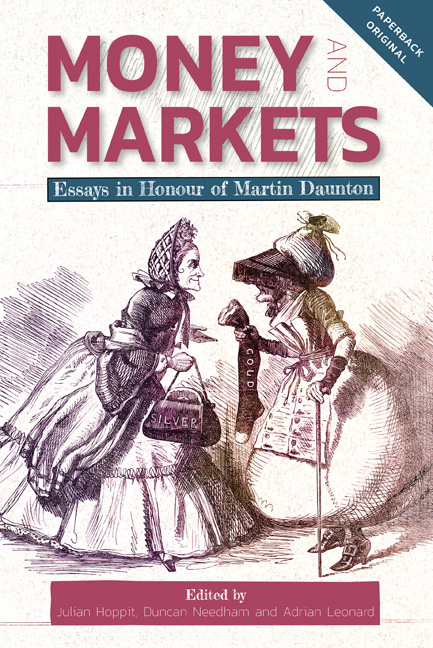Book contents
- Frontmatter
- Contents
- List of Figures
- List of Tables
- List of Contributors
- List of Abbreviations
- Introduction
- 1 Taxing London and the British Fiscal State, 1660–1815
- 2 Rents, Squalor, and the Land Question: Progress and Poverty
- 3 Marine Insurers, the City of London, and Financing the Napoleonic Wars
- 4 The Political Economy of Sir Robert Peel
- 5 Champagne Capitalism: France’s Adaptation to Britain’s Global Hegemony, 1830–80
- 6 The 1848 Revolution in Prussia: a Financial Interpretation
- 7 Imperial Germany, Great Britain and the Political Economy of the Gold Standard, 1867–1914
- 8 Knowledge, Contestation and Authority in the Eurodollar Market, 1959–64
- 9 Continuity and Change in British Conservative Taxation Policy, c. 1964–88
- 10 Britain Since the 1970s: a Transition to Neo-Liberalism?
- 11 Maplin: the Treasury and London’s Third Airport in the 1970s
- 12 Workfare and the Reinvention of the Social in America and Britain, c. 1965 to 1985
- 13 Charity and International Humanitarianism in Post-War Britain
- 14 Discounting Time
- 15 The Material Politics of Energy Disruption: Managing Shortages Amidst Rising Expectations, Britain 1930s–60s
- The Published Writings of Martin J. Daunton
- Index
- People, Markets, Goods: Economies and Societies in History ISSN: 2051-7467
5 - Champagne Capitalism: France’s Adaptation to Britain’s Global Hegemony, 1830–80
Published online by Cambridge University Press: 13 April 2021
- Frontmatter
- Contents
- List of Figures
- List of Tables
- List of Contributors
- List of Abbreviations
- Introduction
- 1 Taxing London and the British Fiscal State, 1660–1815
- 2 Rents, Squalor, and the Land Question: Progress and Poverty
- 3 Marine Insurers, the City of London, and Financing the Napoleonic Wars
- 4 The Political Economy of Sir Robert Peel
- 5 Champagne Capitalism: France’s Adaptation to Britain’s Global Hegemony, 1830–80
- 6 The 1848 Revolution in Prussia: a Financial Interpretation
- 7 Imperial Germany, Great Britain and the Political Economy of the Gold Standard, 1867–1914
- 8 Knowledge, Contestation and Authority in the Eurodollar Market, 1959–64
- 9 Continuity and Change in British Conservative Taxation Policy, c. 1964–88
- 10 Britain Since the 1970s: a Transition to Neo-Liberalism?
- 11 Maplin: the Treasury and London’s Third Airport in the 1970s
- 12 Workfare and the Reinvention of the Social in America and Britain, c. 1965 to 1985
- 13 Charity and International Humanitarianism in Post-War Britain
- 14 Discounting Time
- 15 The Material Politics of Energy Disruption: Managing Shortages Amidst Rising Expectations, Britain 1930s–60s
- The Published Writings of Martin J. Daunton
- Index
- People, Markets, Goods: Economies and Societies in History ISSN: 2051-7467
Summary
In 1882 Henry Vizetelly asserted that if the taste for the wine of Champagne had spread on a planetary scale, with aficionados from Africa to Japan, nowhere and not even in France had it acquired as prominent a status as in Britain. Indeed, its success ‘in oiling the wheels of social life’ among Britons was such that ‘its eclipse would almost threaten a collapse of our social system’. Not only had it become the ‘obligatory adjunct’ of countless formal public and private occasions, from the inauguration of new railway junctions to the breakfast of every respectable wedding, but ‘the part that Champagne plays in the City’ was fundamental:
The amount of business … transacted by the aid of the wine is incalculable. Bargains in stocks and shares, tea and sugar, cotton and corn, hemp and iron, hides and tallow, broadcloth and shoddy, are clinched by its agency. On the other hand, many a bit of sharp practice has been forgiven, many a hard bargain has been forgotten, many a smouldering resentment has been forgiven for ever, and many an enmity healed and a friendship cemented, over a bottle of Champagne.
Vizetelly, an editor of the Illustrated London News, was only half-guilty of journalistic exaggeration. Nearly nine out of ten (88 per cent) of the 20 million bottles of French champagne purchased in 1880 were sold outside France, and Britain was by far the largest market. Between 1860 and 1880, British sales represented between 50 and 60 per cent of the exports of Moet & Chandon, the leading producer of champagne, and it was in response to the demand of British consumers that the firm, along with its competitors, began to produce the drier types of champagne (sec, brut) that are today the commodity's most common iterations. Champagne was produced in France, and intensive advertising endowed the wine with supposedly French qualities such as a sophisticated joie de vivre and ‘sparkling’ wit, but Britons and other Anglo-Saxons were its chief consumers.
Champagne, this chapter shows, was typical of France's adaptation to nineteenth-century globalisation.
- Type
- Chapter
- Information
- Money and MarketsEssays in Honour of Martin Daunton, pp. 91 - 108Publisher: Boydell & BrewerPrint publication year: 2019



